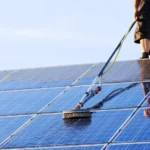WoR Rotary Kiln Shell Replacement Service
Rotary kiln shell replacement involves the project management of design, supply, install and commissioning.
In this challenging project, we need a dynamic team with extensive experience, timely response, and quality engineering.
Steps to Replace Rotary Kiln Shell Sections
(Credits to The Cement Institute)
- Before starting to work in the kiln, safety locks must be implemented, complying with the Lockout/Tagout procedures established in your plant.
- Depending on where the damaged section of the kiln is located, remove the bricks or chains, etc., and perform a thorough claning.
- Appropriate scaffolding should be erected with external work platforms around the affected area and inside the kiln shell.
- Manufacture two spider supports and weld into the existing kiln approximately one meter from the joints of the replacement section. Angular sections of 75mm x 75mm x 10mm welded to a diameter of 400mm. Central disk is recommended. Spiders are installed to maintain cylindrical dimensions during repair.
- A similar structure is recommended at each end and within the center of the new replacement kiln section. During the complete repair, the kiln must be turned manually as necessary to help the convenient positioning of the weld (8 spokes for 4.2m kiln, and 10 spokes for 4.8m kiln).
- The weight of the kiln must be supported by hydraulic jacks, mounted on wooden sleepers or steel support structures manufactured on each side of the replcement area and located under the spider reinforcements.
- Carefully mark the precise reference points around the kiln on the cutting line. Place Bugo’s magnetic track around the circumference of the kiln and secure it with clamps. Make sure the cutting head follows the reference marks.
- The first cut must be 150mm within the required length around the circumference, leaving four sections intact, approximately 300mm wide at 12, 3, 6, and 9 on a clock face.
- Re-establish the track and re-cut the circumference on the actual length cut line. This will leave four 150mm sections uncut.
- Rotate the cutting head at a 30 degree angle and repeat the process on the true cut line. This will affect a chamfer that leaves a rounded tip 2mm wide. Leave the four sections uncut as with the previous cuts. Perform the cutting process in this way at the other end of the damaged section, to leave a true measure for the prefabricated kiln cylinder.
- While the kiln is still intact in this way, a series of supports (brackets) for the extraction bolts must be welded in place. Two main versions of the screw extraction brackets are used. Some kiln suppliers recommend an angle cove design, while others prefer a “U” shaped format. Both are suitable. They are evenly welded around te interior of the existing kiln at both ends and are approximately 400mm apart.
- With the crane in position, the four areas at each end can be cut and the damaged part of the kiln can be removed. Profile the same 30 degree angle to these sections, as recommended above. The damaged section of the kiln is supported by a mobile crane, which must be able to lift the total weight of the component.
- Lift the new section of the kiln and place it in line. This cylinder is also prepared with a front angle of 30 degree. In alignment, it may be necessary to trim again for a good fit-up. When positioned, the welding joint will be at an included angle of 60 degree, preparing a single “V” with a 2mm rounded tip on both sides.
- Verify the alignment and fully weld along one side, a series of approximately 15 “strong-backs” along the two joints.
- Weld the extraction bolt brackets to the new section to align with the previously welded parts. Insert fully threaded 30 mm thread screws into the joint and secure 4 hex nuts per unit, two outside and two inside the bracket, to create a push and pull mechanism. Weld in place a series of approximately 30 screw blocks spaced apart to the new section to cross the joint. Adjusted to align both cylinders.
- Turn the kiln manually to perform a true alignment check. As the kiln rotates, 12 reference points are selected and measured using a Polar diagram, one meter away from each joint. This determines the true centerline of the kiln. If the test is unsatisfactory, strong reinforcements are released with grooves and traction bolts are adjusted where necessary. Strong backs are re-welded and an additional alignment check is performed until the kiln is within tolerance.
- Before welding, preheating is critical. The correct preheating temperature has been previously calculated in this procedure. The ideal for this base material with its cross section is 200 degree C, although in the application it has been found that it is difficult to achieve due to the effects of the mass and the heat sink. Preheating of 120 degree C at a distance of 150mm from each side of the joint in practice has been satisfactory.
- A thermal crayon, or preferably a pyrometer will be used during welding to ensure that this temperature is maintained. Reheat as necessary.
- The recommended electrodes (please, reference to Case Study for the Welding of Replacement Kiln Sections) should be preheated for 2 hours at 200 degree C in a suitable baking oven. Remove 10 electrodes at a time and transport them to the workplace in portable heated shakers. It is recommended that welding contractors are in possession of a current coded certificate for EN287 or ASME9. These should be available for inspection if necessary.
- Start welding from the outside of the kiln, using two welders on each joint that work continuously throughout the day. This will accelerate the downtime of the cement plant and reduce reheating operations. Fully deposit a single-pass root weld using 3.2mm electrodes. Observe the operator positioning sketch for welding. Remove bottom slag using an air chisel. Inspect for inclusions, if present, move and weld again.
- Hot welding and intermediate welding can be completed in stages to fill 2/3rds of the welding preparation. To obtain optimum mechanical strength, weaving should be avoided, therefore, use reinforcement cords up to a deposit width of twice the electrode diameter. Return to the inside of the kiln and remove it with gouged, screw blocks, strong backs and spider stands. Grind these gouged areas flush.
- Using carbon electrodes 8 mm in diameter and the air arc gouging process, perform an internal root preparation by inserting the outer root weld again at a depth of approximately 10 to 15mm, depending on the shell thickness. This will also eliminate any possible slag inclusion. Grind in the form of “U” to remove all waste from gouging. Be sure to maintain preheating and deposit an internal root weld using 3.2mm electrodes. Complete the hot pass and the last pass with 4mm electrodes. Grind the internal surface flush, as welds that are undermined or undercut can have the effect of multiplying stress.
- Return to the outside and complete the filling and capping weld deposits, ensuring stringer bead format, using 4mm or 5mm electrodes. Wire brush inside and out and visually inspect completed welds. Suspicious areas should be investigated using penetrating dyes or preferably ultrasonic tests. Weld is subject to a 100% radiography at the end. Gouge and weld again any defect.
- Remove scaffolding and auxiliary equipment. Replace any internal brick or chain work that is necessary. Return to service.
- The correct alignment of the kiln may be necessary to obtain an optimum service life of both the mechanical components and the refractory. Excessive loads should not be transferred throughout the kiln. When finished, the best way is a hot alignment. A shell map can be supplied. Whenever this is done with the kiln running in normal conditions, it will show the actual position of execution on the shell map.
If you would like to know more about Kiln Shell Replacement, please join our upcoming seminar “CEMENT RELIABILITY MAINTENANCE SEMINAR”.






